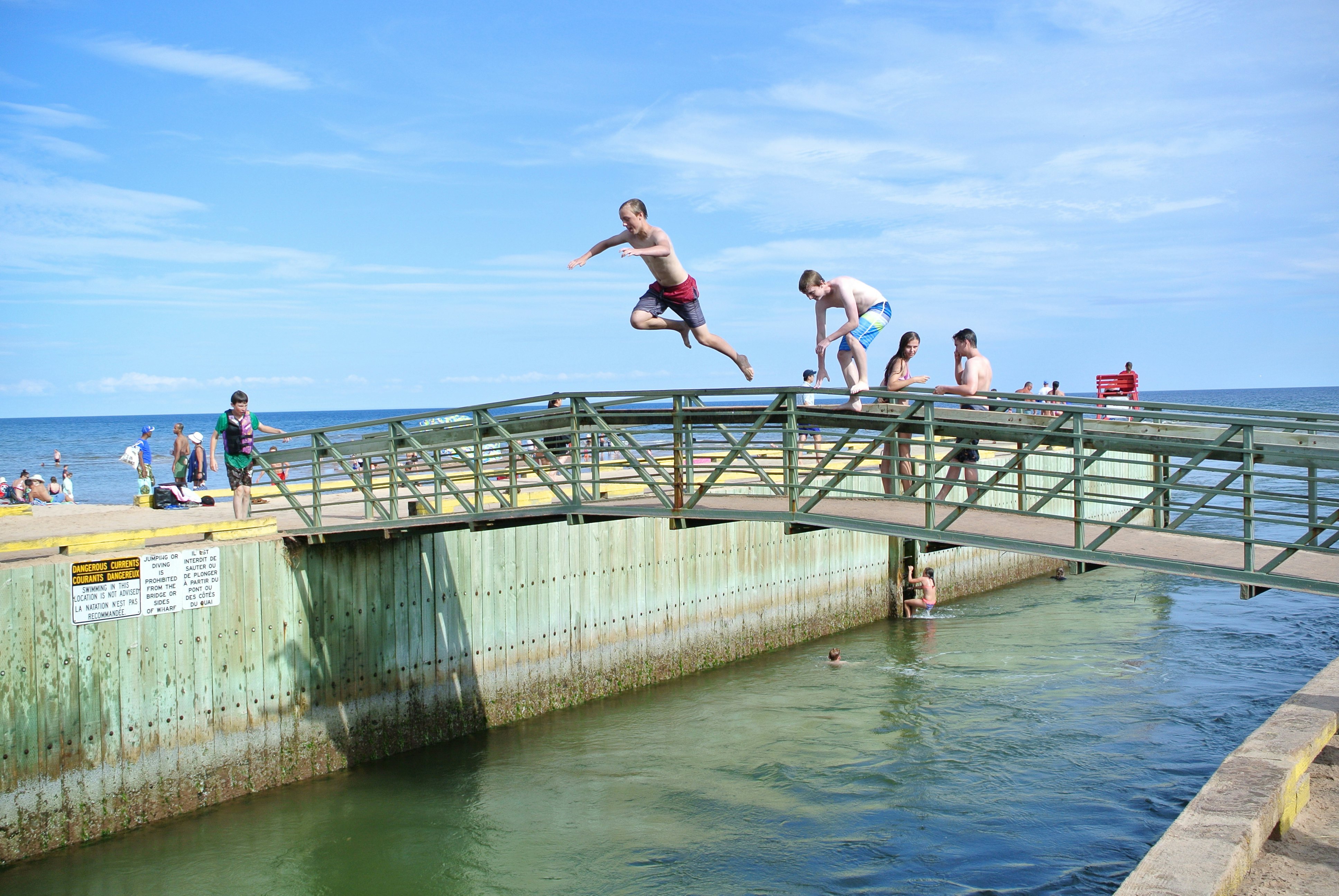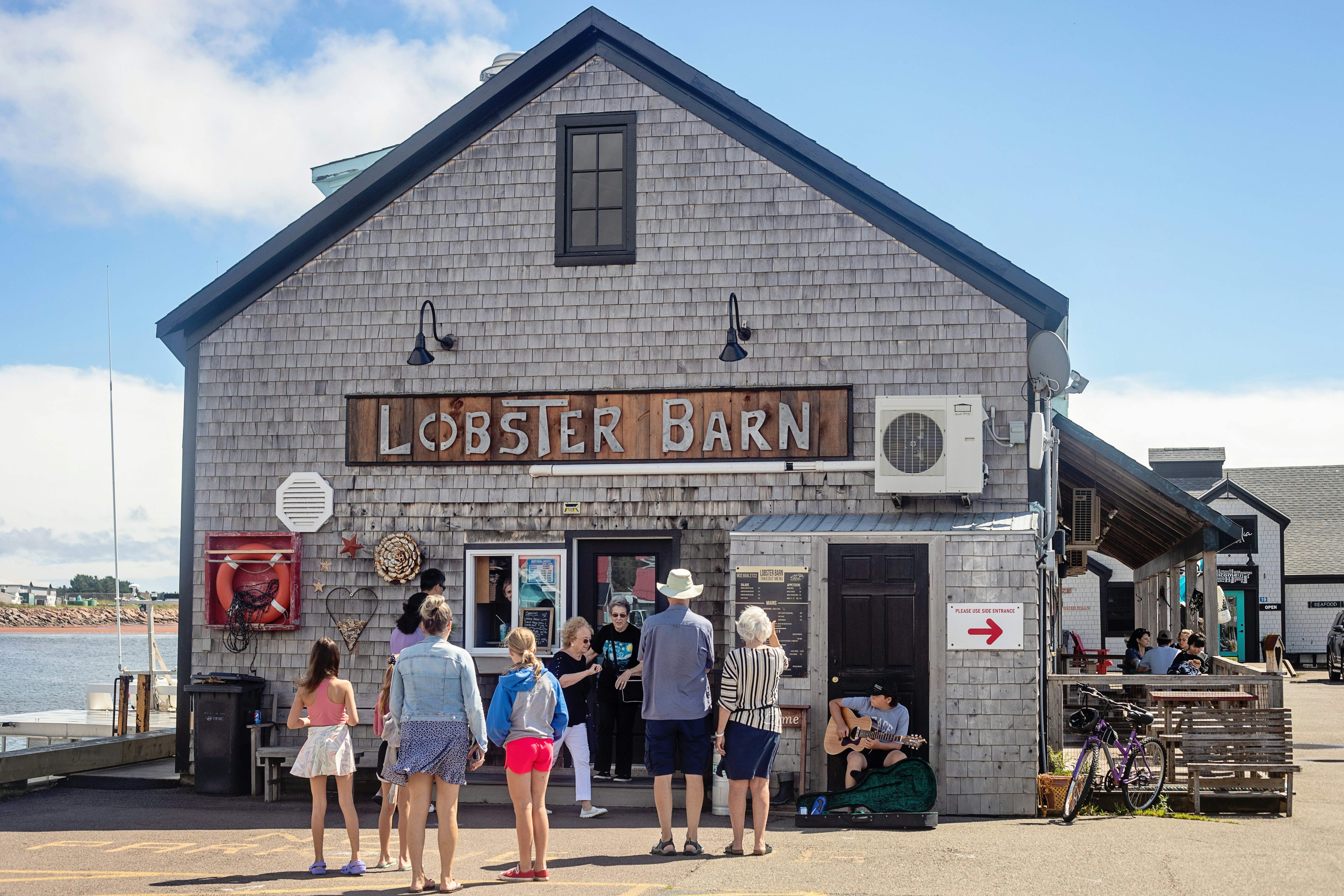

Covehead Lighthouse on Prince Edward Island. Vadim.Petrov/Shutterstock
Long sandy beaches backed with red cliffs. Freshly caught lobster, oysters and clams. Toe-tapping music at lively kitchen parties or local pubs. And plenty of outdoor adventures, from cycling to kayaking to hiking. In the Gulf of St Lawrence, on Canada’s eastern shores, Prince Edward Island (PEI) may be the country’s smallest province, but there’s plenty to see and do.
Besides its natural setting, PEI’s other claim to fame is a series of early 20th-century novels about a feisty red-haired girl. Lucy Maud Montgomery set the Anne of Green Gables books around Cavendish, her PEI hometown. Several island attractions can tell you more about the noted author and the beloved Canadian character she created.
Prince Edward Island is a wonderful stop along an Atlantic Canada road trip – the nearly 13km-long (8-mile) Confederation Bridge connects PEI to the mainland (in New Brunswick) – or just devote a trip to this province, nicknamed “Canada’s food island.” Here's our guidance for planning a trip to Prince Edward Island.

When should I go to Prince Edward Island?
PEI shines under the summer sun, its short peak season running from late June into September. The weather is typically warm, with temperatures hovering around 20ºC to 25ºC (70ºF to 80ºF), prime time for beach-going, hiking and picnicking. One summer highlight to catch is the Fireworks Feast, a very special four-hour farm dinner held nightly in May to October at the Inn at Bay Fortune. With cooler mornings and evenings, the weather stays temperate into October, as the leaves take on their autumn reds and golds. Fall brings food fests, too, including the Fall Flavours Festival and the PEI International Shellfish Festival.
Many island businesses are seasonal, opening in May or June and closing in September or by the Canadian Thanksgiving weekend in October. Prices are typically somewhat lower in the shoulder months of May, June, September and October. Expect more rain and varied temperatures in both fall and spring, although you might have mild, sunny days, as well – good for hiking, bicycling and island exploring.
The Atlantic hurricane season officially runs from June to November, although the worst storms have previously hit the maritime provinces in the fall. Expect snow anytime between November and April, with fierce winter winds making the temperatures feel much colder than the average ranges of -11ºC to -3ºC (11ºF to 26ºF).
How much time should I spend on Prince Edward Island?
If you have a long weekend, start in Charlottetown, exploring the province’s historic capital, and learn about its role as the “the birthplace of Confederation,” creating the union that would become the country of Canada. Have a drink overlooking the waterfront, then grab a bite from one of the vendors in Founders Food Hall. Your next stop is Cavendish on the island’s north shore, where several sights tell you about the Anne of Green Gables story. Then explore the beaches of Prince Edward Island National Park, perhaps taking a hike through the Greenwich dunes before dinner at Dalvay by the Sea, a historic summer home turned inn. The next day, go kayaking or cycling. Dig into a traditional lobster supper, ending your trip with music in a local pub.
To explore more of the island, plan a one-week road trip. After your time in Charlottetown, Cavendish and the national park, drive west for an Indigenous cultural experience on Lennox Island, a Mi’kmaq community. Circle the island’s west side, sampling the spuds at the Canadian Potato Museum, stopping for a lunchtime concert at the Stompin’ Tom Centre and spending the night in the West Point Lighthouse. Returning to Charlottetown, stop off in the village of Victoria by the Sea for a lobster roll or freshly steamed mussels. If you have more time, continue east to Souris for a cruise on a lobster boat.

How do I get to Prince Edward Island?
Fly non-stop to Charlottetown Airport (YYG) from Toronto, Montreal and Ottawa year round, and seasonally from Calgary and smaller Canadian cities. For more flight options, consider jetting into Nova Scotia’s Halifax Stanfield International Airport (YHZ), which has non-stop flights to additional Canadian, US and European cities. It’s a three-hour drive or bus trip from Halifax airport to PEI over the Confederation Bridge. Maritime Bus can take you to Charlottetown from Halifax airport or from other destinations in Nova Scotia and neighboring New Brunswick.
Although PEI has no train service, Canada’s national rail carrier, Via Rail, can bring you from Montreal or Quebec City to Halifax or to Moncton, New Brunswick. From there, take the bus or rent a car to continue to the island.
How do I get around Prince Edward Island?
In compact, walkable Charlottetown, most attractions are along the waterfront or in the historic center. Outside the city, having a car is your best bet.
T3 Transit, the island’s public transit service, runs buses to Charlottetown Airport and around the city. T3 Transit’s rural routes provide limited service between Charlottetown and other island destinations. While services are infrequent, the fares are fantastic value – only $2 (US$1.46) to travel anywhere on the island.
PEI is relatively flat, making it a good destination for cyclists. Following the route of a decommissioned rail line, the Confederation Trail runs 273km (170 miles) through the island center, and you can also cycle the Island Walk, which takes you primarily on less-busy roads.

Top things to do on Prince Edward Island
Go to the beach
PEI has dozens of them. Some of the best stretches of sand are along the north shore in Prince Edward Island National Park, but there are sandy beaches around the island.
Dive into a novel
Learn the story of Anne of Green Gables, one of Canada’s most beloved fictional characters, and her creator Lucy Maud Montgomery at sights like Green Gables Heritage Place or Anne of Green Gables Museum. Stop by any of the province's bookstores to pick up a copy.
Catch your dinner with a fiddling fisherman
JJ Chaisson is a lobster fisher and musician. Along with his wife Julie, he runs The Fiddling Fisherman, taking guests out on their family fishing boat for a lobster dinner, accompanied by music from Chaisson’s fiddle.
Learn about Indigenous culture
Take a food, music or art workshop in the First Nations community of Lennox Island. You might learn to bake bannock – a biscuit-like bread – over an open fire, get an introduction to traditional quill work, or craft your own moose-hide drum.
Clap along at a ceilidh
Drawing on Irish, Scottish and maritime traditions, a ceilidh (pronounced KAY-lee) is part concert and part kitchen party, blending lively fiddle music, singing, dancing and storytelling. These musical events take place in pubs, community halls and concert venues across Prince Edward Island.

My favorite thing to do on Prince Edward Island
My favorite thing to do on PEI is walk, following sections of the Island Walk, a 700km (435-mile) route around the entire isle. Modeled after Spain’s Camino de Santiago (though without a pilgrimage history), the Island Walk has 32 sections of 20km to 25km (12 to 15 miles) each, which take you along PEI’s sandy beaches and into its forests, above its red cliffs and through its small towns. Walk for a day, a week or more, listening to the splash of the surf, the chirps of the birds and the quiet sounds of island life.
Local outfits Go for a Walk: Island Walk Coordination Service and Outer Limit Sports can organize a walking itinerary, provide luggage transfer services and arrange accommodations. You can cycle the Island Walk, too. MacQueen’s Bike Shop in Charlottetown rents bicycles and provides trip-planning services.
How much money do I need for Prince Edward Island?
While PEI isn’t as pricey as major Canadian cities like Vancouver or Toronto, it’s not inexpensive either, especially during the summer high season. The island has only a few budget lodgings, with dorm beds starting at $50 (US$36.62) and basic doubles around $120 (US$87.88). Many traditional inns and B&Bs fall into the midrange, beginning around $150 (US$109.85) per night. If you’re budget-conscious, consider a cottage or motel room with a kitchen where you can prepare some of your own meals.
Take public transit if you can. T3 Transit fares for adults are only $2 (US$1.46) a ride, whether you’re traveling within the capital or across the island, and kids ride free. Neither Uber nor Lyft currently operate on PEI, but Kari, a local rideshare company, provides service, primarily in the Charlottetown area. Depending on the season, car rentals in Charlottetown range from $50 (US$36.62) to more than $100 (US$73.24) per day.
Average daily costs on PEI:
Coffee: $3 to $4 (US$2.20 to US$2.93)
Craft beer in an island taproom: $8 to $10 (US$5.86 to US$7.32)
Pound of PEI mussels: $14 $18 (US$10.25 to US$13.18)
Lobster roll: $27 and up (US$19.77)
Traditional lobster supper: $50 to $60 per person (US$36.62 to US$43.94)
Wear the lobster bib
Many seafood restaurants give you a bib to wear if you’ve ordered a whole lobster. Don’t be shy – tie it on to protect your clothes. Eating a lobster can be a messy business.
Pack layers and rain gear
While the weather is generally temperate from spring through fall, it can get breezy and cool by the shore or in the evening and it can rain at any time. Keep a light jacket or sweater in your day pack. PEI winters are cold, damp and often snowy. Not only do you need warm jackets, hats, gloves and boots, but be prepared for winter travel conditions, including snow-covered roads and high winds.
It’s colder on the water
If you’re heading out on a lobster boat or other cruise, remember that it’s chillier on the water, even in summer. Bring a jacket or clothes you can layer.
“Ask an Islander”
If you want to know more about Prince Edward Island or have a question while planning your trip, “Ask an Islander.” On the website of Tourism PEI, the provincial tourism organization, you can post a question and a local resident will answer your query.















